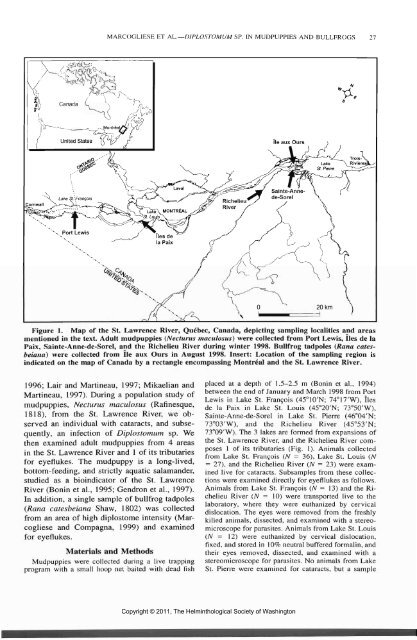Comparative Parasitology 67(1) 2000 - Peru State College
Comparative Parasitology 67(1) 2000 - Peru State College
Comparative Parasitology 67(1) 2000 - Peru State College
Create successful ePaper yourself
Turn your PDF publications into a flip-book with our unique Google optimized e-Paper software.
MARCOGLIESE ET AL.—DIPLOSTOMUM SP. IN MUDPUPPIES AND BULLFROGS 27<br />
Figure 1. Map of the St. Lawrence River, Quebec, Canada, depicting sampling localities and areas<br />
mentioned in the text. Adult mudpuppies (Necturus maculosus) were collected from Port Lewis, lies de la<br />
Paix, Sainte-Anne-de-Sorel, and the Richelieu River during winter 1998. Bullfrog tadpoles (Rana catesbeiana)<br />
were collected from lie aux Ours in August 1998. Insert: Location of the sampling region is<br />
indicated on the map of Canada by a rectangle encompassing Montreal and the St. Lawrence River.<br />
1996; Lair and Martineau, 1997; Mikaelian and<br />
Martineau, 1997). During a population study of<br />
mudpuppies, Necturus maculosus (Rafinesque,<br />
1818), from the St. Lawrence River, we observed<br />
an individual with cataracts, and subsequently,<br />
an infection of Diplostomum sp. We<br />
then examined adult mudpuppies from 4 areas<br />
in the St. Lawrence River and 1 of its tributaries<br />
for eyeflukes. The mudpuppy is a long-lived,<br />
bottom-feeding, and strictly aquatic salamander,<br />
studied as a bioindicator of the St. Lawrence<br />
River (Bonin et al., 1995; Gendron et al., 1997).<br />
In addition, a single sample of bullfrog tadpoles<br />
(Rana catesbeiana Shaw, 1802) was collected<br />
from an area of high diplostome intensity (Marcogliese<br />
and Compagna, 1999) and examined<br />
for eyeflukes.<br />
Materials and Methods<br />
Mudpuppies were collected during a live trapping<br />
program with a small hoop net baited with dead fish<br />
placed at a depth of 1.5-2.5 m (Bonin et al., 1994)<br />
between the end of January and March 1998 from Port<br />
Lewis in Lake St. Francois (45°10'N; 74°17'W), lies<br />
de la Paix in Lake St. Louis (45°20'N; 73°50'W),<br />
Sainte-Anne-de-Sorel in Lake St. Pierre (46°04'N;<br />
73°03'W), and the Richelieu River (45°53'N;<br />
73°09'W). The 3 lakes are formed from expansions of<br />
the St. Lawrence River, and the Richelieu River composes<br />
1 of its tributaries (Fig. 1). Animals collected<br />
from Lake St. Francois (N = 36), Lake St. Louis (N<br />
= 27), and the Richelieu River (N = 23) were examined<br />
live for cataracts. Subsamples from these collections<br />
were examined directly for eyefllukes as follows.<br />
Animals from Lake St. Francois (N = 13) and the Richelieu<br />
River (N = 10) were transported live to the<br />
laboratory, where they were euthanized by cervical<br />
dislocation. The eyes were removed from the freshly<br />
killed animals, dissected, and examined with a stereomicroscope<br />
for parasites. Animals from Lake St. Louis<br />
(N = 12) were euthanized by cervical dislocation,<br />
fixed, and stored in 10% neutral buffered formalin, and<br />
their eyes removed, dissected, and examined with a<br />
stereomicroscope for parasites. No animals from Lake<br />
St. Pierre were examined for cataracts, but a sample<br />
Copyright © 2011, The Helminthological Society of Washington
















